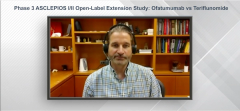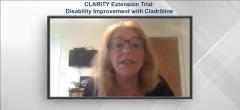
Rationale for Selected Dosing Regimen of Evobrutinib in Phase 3 Studies
Episodes in this series

A discussion of evobrutinib’s long-term efficacy and safety among 4 dosing regimens and rationale for the regimen selected for phase 3 studies.
Mark Freedman, MD, MSc: The final trial to review here is another clinical study, which is also a follow-on from a published study of evobrutinib. Evobrutinib is one of the first BTK [Bruton tyrosine kinase] inhibitors that have come to bear in multiple sclerosis. It is 1 of 4 that are now being tested by the various companies to look at the effect of reducing relapse. This is not only because of their theoretical effect on B cells, but also because BTK inhibitors affect microphage and microglia, which might be driving some aspect of progressive disease. Hence, you’re going to get the B-cell phenomenon by reducing the B-cell output, but also perhaps affect another process that might be driving disease progression.
The evobrutinib original study looked at 4 different doses. This is an attempt to look at the long-term efficacy of evobrutinib going out to week 48. It looks at the long-term outcome of a phase 2 study, which was originally just a 6-month or 24-week trial looking primarily at MRI as an outcome measure. They decided to look at these longer-term impacts at 48 weeks, as measured by clinical outcomes such as relapse rates, time to relapse, change in EDSS [Expanded Disability Status Scale], and safety.
This was the original double-blind trial of 4 different doses of evobrutinib—25 mg once daily, 75 mg once daily, 75 mg twice daily, or the placebo—for the first 24 weeks. They were all continued on their original treatment blinded until week 40, except the placebo patients, who were rolled over. They were switched to the lowest dosage of 25 mg daily. Then, at week 48, they could go into an open-label extension through which they would initially receive 75 mg daily. That was for a median time of 48 weeks. Then, they would switch to 75 mg twice per day. One was looking well beyond the 48 weeks to week 60 on the open-label extension.
This is a smaller study in the realm of phase 2 versus phase 3, which we discussed before. The number of patients was much lower. We had 213 patients originally randomized. Of those, only 77% or so entered the open-label extension. Of those, 90% completed up to 108 weeks of treatment extension for the purposes of further analysis. There are 4 different groups that we’re looking at. For the patients initially receiving the placebo, 25 mg per day, 75 mg per day, or 75 mg twice a day in the double-blind period, 1 analysis looked at ARR [annualized relapse rate]. That was still quite low at 0.37. The ARRs were 0.37 for the placebo, and 0.52, 0.25, and 0.11 for the various doses of evobrutinib. It is interesting that the low dose had a slightly higher relapse rate than the original placebo, but the lowest rate was still seen at 75 mg bid [twice a day] at week 48. They then looked at similar numbers going out to week 108. The 0.11 at 75 twice a day was maintained to 0.12.
Going out to week 48, the cumulative probability of qualified relapse was consistent across the groups and was lowest at the highest dosage of evobrutinib through to week 96. At that point, the relapse rate remained low at 0.2. The estimated time for randomization, in those 20% of patients who had a qualified relapse, was 3 times longer for the patients that initiated evobrutinib 75 mg twice daily during the double-blind period than for patients in the other arms or placebo. It looks like the 75 mg twice daily is the dosage of interest going forward. The safety profile in the extension study failed to reveal anything new compared with the double-blind period. The message here is that the 75 mg twice a day dosage also happened to correlate with the best result and the optimal occupancy of tyrosine kinase. I believe this is the dosage that they’re going forward with in the phase 3 studies.
Because phase 3 is now ongoing and recruiting at the dosage of 75 mg twice daily, one wants to understand the rationale for choosing that dosage. Although it may not have been readily evident at 24 weeks from the phase 2 primary outcome measure, the continued study and open-label extension of evobrutinib supports the moving ahead with the 75 mg twice a day dosing in phase 3.
Newsletter
Keep your finger on the pulse of neurology—subscribe to NeurologyLive for expert interviews, new data, and breakthrough treatment updates.



































